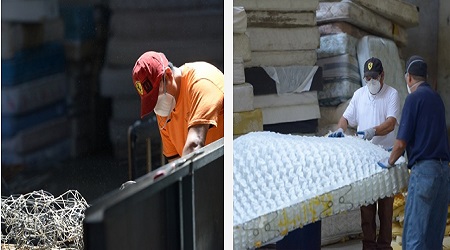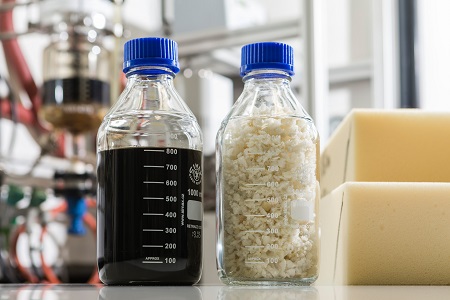Proper handling and disposal of mattress waste was brought into the limelight when the COVID-19 pandemic struck globally. The rise in the number of cases and hospitalisation has pushed utilisation of mattresses, along with other medical disposables such as face masks, personal protective equipment (PPEs), and other medical products. Millions of old mattresses are thrown away each year; discarded mattresses are mainly thermally recycled or disposed of in landfills. In the United States alone, around 18.2 million mattresses are disposed each year with over 50,000 of them ending up in landfills each day.

Because of the huge pile up of mattresses thrown away, recycling is considered the most environmentally-friendly way to properly dispose old mattresses. The Mattress Recycling Council (MRC) estimates that around 75% of mattresses can be recycled. The MRC is a non-profit organisation formed by the mattress industry to operate recycling programs in those states that have enacted mattress recycling laws. Currently, the program is running in the United States – in the states of California, Connecticut and Rhode Island – and is popularly known as Bye Bye Mattress to consumers. Other countries also have organisations engaged in mattress recycling.
Technologies for mattress recycling gain momentum
Several companies in the plastics industry are promoting environment-friendly recycling of mattresses.
Dow Polyurethanes, a business division of Dow, and Orrion Chemicals Orgaform together with Eco-mobilier, H&S Anlagentechnik and The Vita Group have inaugurated a pioneering mattress recycling plant as part of the RENUVA™ program. Under the program, old mattresses made of polyurethane foam are being recovered, dismantled and chemically recycled to create a new polyol, which is a key starting material to produce polyurethane. This RENUVA™ polyol is designed for various applications including mattresses.
The program is a major step forward for the recovery and recycling of polyurethane foam and a significant advance for closing the loop for end-of-life mattresses. At full capacity the plant will process up to 200,000 mattresses per year to tackle the growing mattress waste problem. “We are immensely proud to have unveiled this plant. By doing so we are answering the question of what can be done with recycled polyurethane foam. It is part of Dow’s strong commitment to delivering solutions that help close the loop and protect our environment,” commented Marie Buy, Sustainability Leader EMEAI, Dow Polyurethanes, “As RENUVA™ now shifts focus to the production phase and the first foam made with the new polyol, our Dow Polyurethane sustainability journey continues. We are actively exploring future possibilities for recycled material and potential applications. It is really a new beginning.”

Dow Polyurethanes’ pioneering mattress recycling, the RENUVA™ program,
gives discarded PU foam a new life.
The RENUVA™ mattress recycling plant is the result of strong collaboration between Dow and key players from across the mattress lifecycle: chemical innovator Orrion Chemicals Orgaform, expert mattress collector Eco-Mobilier, turnkey solutions provider H&S Anlagentechnik, and foam manufacturer The Vita Group. “This really is a first for our company and for France. We have a longstanding commitment to creating more sustainable solutions and have long recognised the need for industry to part of the solution,” commented Christian Siest, President, Orrion Chemicals Orgaform, “Our plant uses a chemical recycling process in which the polyurethane foam is decomposed and converted into a novel single product. The great thing about this is versatility; we can process foam from any mattress and the RENUVA™ polyol recipe itself can be tailored for different applications.”
As previously announced, flexible polyurethane foam solutions provider The Vita Group will use the RENUVA™ polyol to create its award-winning Orbis flexible foam, providing a more sustainable offering to the bedding market. “Consumer attitudes have changed significantly, and people are becoming a lot more focused on making sustainable choices. We have already seen strong interest from customers across Europe for Orbis foam and interest in the RENUVA™ technology, providing exciting opportunities for our product lines,” commented Mark Lewis, Operations and Projects Director at The Vita Group, “For over 50 years, Vita has recycled or re-bonded pre-consumer foam trim into material suitable for a range of products such as underlays for flooring. Our collaboration with Dow allows us to take our sustainability vision to the next level and we are extremely proud and excited to play our part in driving this ground-breaking innovation forward.”
Application of chemical recycling process
Another major industry player that has been working to achieve efficient recycling of disposed mattresses is BASF, which has developed a chemical recycling process for used mattresses. The materials from old mattresses are being recycled in such a way that they can be used for the production of new mattresses. The target is to recover the raw materials with a quality comparable to that of non-recycled/virgin raw materials.
BASF’s wet chemical recycling process for used mattresses made of flexible polyurethane has shown promising results during initial small-scale trials. The process breaks down the flexible polyurethane and delivers the initially used polyol. From there BASF can produce new foam with a significantly lower carbon footprint, because fewer fossil resources are used. The original polyols can be recovered from the used mattress foams and used again to produce high-quality flexible foam blocks. The quality of these flexible foam blocks made from recycled polyurethane are equivalent to those made from conventional materials from fossil raw material sources. Thus, high-quality new mattresses can be produced from alternative polyurethane. With this process, BASF steps up its efforts to increase sustainability and takes one step further toward a circular economy.

BASF’s innovative recycling process for used mattresses breaks down
the flexible PU and delivers the initially used polyol.
BASF is working with foam specialist NEVEON to further develop the recycling of mattresses. The aim is to establish a closed product loop for mattresses. BASF and NEVEON want to change this and return mattress foams to the product life cycle. As early as this year, the two companies plan to obtain the first pilot quantities of recycled mattress foams made from collected used mattresses. The next step will then be to transfer the recycling to a larger scale in subsequent years.
"For the recycling of mattresses, cooperation between all stages along the value chain is crucial. Together with NEVEON, we want to build a partner network and close the loop step by step," explains Dr. Sven Crone, responsible for the European business for isocyanates & precursors at BASF. NEVEON CEO Oliver Bruns adds: "The future bears the name circular economy. We as an industry need to drive the transformation to a circular system where products at the end of their life cycle are not waste, but valuable raw material and feedstock for new products. I am therefore pleased to make an important contribution here together with BASF and other partners."
One building block towards a closed cycle - which already starts with the product and eco-design of mattresses - is the systematic collection and return of old mattresses. To simplify this, NEVEON is launching REMATTRESS, a mattress take-back pilot, in Berlin in mid-February. This is to be extended in the coming months successively to further states of the Federal Republic. On the online reservation platform www.remattress.de citizens of Berlin can book immediately fast and comfortably by mouse-click the collection of their old mattresses. This is fetched after date agreement, dismantled professionally, and made available for reprocessing. This makes an important contribution to the circular economy, as the recycled materials can be used to manufacture new foam products.
- This article also appears in International Plastics News for Asia - April issue. To read the e-zine, click here.














